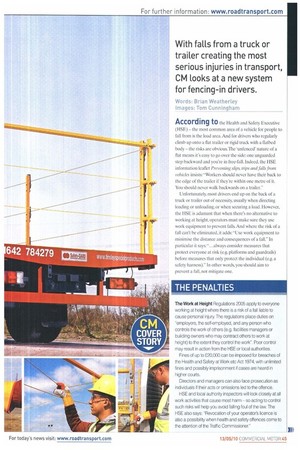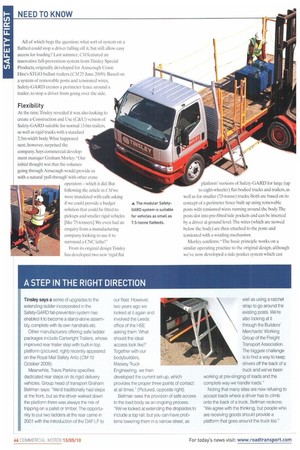With falls from a truck or trailer creating the most
Page 45

Page 46

Page 47

If you've noticed an error in this article please click here to report it so we can fix it.
serious injuries in transport, CM looks at a new system for fencing-in drivers.
Words: Brian Weatheit Images: Tom Cunnin
According to the Health and Safety Executive (HSE) the most common area of a vehicle for people to fall from is the load area. And for drivers who regularly climb up onto a flat trailer or rigid truck with a flatbed body the risks are obvious. The 'unfenced nature of a flat means it's easy to go over the side: one unguarded step backward and you're in free-fall. Indeed, the HSE information leaflet Preventing slips, trips and falls from vehicles insists: "Workers should never have their back to the edge of the trailer if they're within one metre of it. You should never walk backwards on a trailer."
Unfortunately, most drivers end up on the back of a truck or trailer out of necessity, usually when directing loading or unloading, or when securing a load. However, the HSE is adamant that when there's no alternative to working at height, operators must make sure they use work equipment to prevent falls. And where the risk of a fall can't be eliminated, it adds: Use work equipment to minimise the distance and consequences of a fall.In particular it says: "...always consider measures that protect everyone at risk (e.g, platforms and guardrails) before measures that only protect the individual (e.g. a safety harness)." In other words, you should aim to prevent a fall, not mitigate one. All of which begs the question: what sort of system on a flatbed could stop a driver falling off it, but still allow easy access for loading? Last summer, CM featured an innovative fall-prevention system from Tinsley Special Products, originally developed for Ainscough Crane Hire's STGO ballast trailers (CM 25 June 2009). Based on a system of removable posts and tensioned wires. Safety-GARD creates a perimeter fence around a trailer, to stop a driver from going over the side.
Flexibility
At the tiine.Tinsley revealed it was also looking to create a Construction and Use (C&U) version of Safety-GARD suitable for normal 13.6m trailers, as well as rigid trucks with a standard 2.5m-width body. What happened next, however, surprised the company. Says commercial development manager Graham Morley: Our initial thought was that the volumes going through Ainscough would provide us with a natural 'pull-through' with other crane operators—which it did. But following the article in CM we were inundated with calls asking if we could provide a budget solution that could be fitted to pickups and smaller rigid vehicles [like 7.5-tonnerst We even had an enquiry from a manufacturing company looking to use it to surround a CNC lathe!"
Rom its original design Tinsley has developed two new 'rigid flat platform' versions of Safety-GARD for large (up to eight-wheeler) flat-bodied trucks and trailers, as well as for smaller (7.5-tonne) trucks. Both arc based on its concept of a perimeter fence built up using removable posts with tensioned wires running around the body. The posts slot into pre-fitted side pockets and can be inserted by a driver at ground level The wires (which are stowed below the body) are then attached to the posts and tensioned with a winding mechanism.
Morley confirms: "The basic principle works on a similar operating practice to the original design, although we've now developed a side-pocket system which can take the posts within a modified side rave. In essence, you should be able to modify all side raves, though it's probably prudent to check with us first."
To allow quick loading on a flatbed. Tinsley offers a 'split' version of SafetyGARD, with two individual winders at the front of the body, which allows a driver to keep the wire barrier erected on one side, while providing a loading aperture for a forklift on the other." You can leave a loading gap as you don't have to have the cable around every single post," says Morley. "And in that way it becomes more versatile. You can also run the cable below the platform height, then raise it when you need it."
Tinsley has already fitted its Safety-CARD rigid flat platform system to three of Ainscough's 26-tonne flatbed Scanias, which have front-mounted cranes. It is also developing a version for utilities and councils that can be fitted to a dropside body: this uses the existing middle and end securing pillars. and also features kick-panels. Morley says the system will be 'reversible' so it will not compromise the condition of lease or hire vehicles at the end of a contract. "They can basically turn the vehicle back to what it was."
Pricing
One of the major issues for Tinsley has been how to price the C&Li Safety-CARD competitively. "The biggest hurdle we've had to face has been the value of the system when set against the total price of the trailer or the truck," acknowledges Morley. "So we've come up with a slightly lower spec, but which still does the same job. We now do a post and pocket assembly working kit with galvanised [rather than painted] side posts, but which still allows the operator to specify various pocket options, for under £2,000."
With sonic 70 Safety-CARD systems already in operation, Morley reports a good record for durability. "Ainscough has been running it since last March [2009] and so far we've only had to replace four cables in the whole year, and they were damaged during loading. We've also changed a couple of pulley wheels, but otherwise we've had no major problems."
Since the launch of the original Safety-GARD,Tinsley has further modified the system's extendible ladder, which provides easy access to the flatbed. "We've changed it so the hinge bracket now allows you to fold the ladder back against the headboard when you don't need it," says Morley. "We did have to replace a couple of ladders, but these were damaged after being left out when the driver reversed. But we've not had any problems with the ladders themselves and the system is patented."
The folding ladder incorporated within Safety-GARD provides significantly safer access to the flat-body ladders compared with the small ladders normally found at the rear of a trailer or truck body (see box, above). And with the need to provide proper access a part of any working at height risk assessment. it is worth consideration for a regular curtainsider or dry freight body,. Meanwhile. Morley says further new versions of the fall-prevention system are planned for 2010. "We'll continue to improve and develop the system under the Safety-CARD brand." •
































































































































